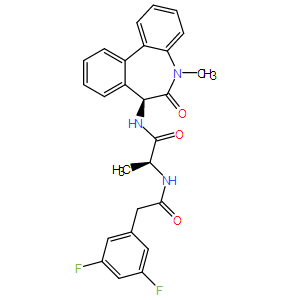| Cas No.: | 209984-56-5 |
| Chemical Name: | N-[(1S)-2-[[(7S)-6,7-Dihydro-5-methyl-6-oxo-5H-dibenz[b,d]azepin-7-yl]amino]-1-methyl-2-oxoethyl]-3,5-difluorobenzeneacetamide |
| Synonyms: | YO-01027, YO01027, Dibenzazepine, Deshydroxy LY 411575,DBZ |
| SMILES: | C[C@@H](C(=O)N[C@H]1C2=CC=CC=C2C3=CC=CC=C3N(C1=O)C)NC(=O)CC4=CC(=CC(=C4)F)F |
| Formula: | C26H23F2N3O3 |
| M.Wt: | 463.48 |
| Purity: | >98% |
| Sotrage: | 2 years -20°C Powder, 2 weeks 4°C in DMSO, 6 months -80°C in DMSO |
| Description: | YO-01027 (Dibenzazepine;DBZ) is a potent γ-secretase inhibitor with IC50 values of 2.92±0.22 and 2.64±0.30 nM for Notch and APPL cleavage, respectively. |
| Target: | IC50: 2.92±0.22 (Notch), 2.64±0.30 (APPL) nM[1] |
| In Vivo: | DBZ blocks activated Notch1 signaling in abdominal aortic aneurysm (AAA) tissue from both Ang II-infused Apo E-/- mice and human undergoing AAA repair. DBZ markedly prevents Ang II-stimulated accumulation of macrophages and CD4+ T cells, and ERK-mediated angiogenesis, simultaneously reverses Th2 response, in vivo[3]. Administration of DBZ markedly attenuates renal fibrosis and expression of fibrotic markers, including collagen 1α1/3α1, fibronectin, and α-smoothmuscle actin. DBZ significantly inhibits ureteral obstruction -induced expression of transforming growth factor (TGF)- β, phosphorylated Smad 2, and Smad 3[4]. |
| In Vitro: | Increasing concentrations of DBZ administered to APPL- or Notch-expressing cells leads to the progressive accumulation of APPL CTF fragments and a decrease in NICD production in a strictly dose-dependent manner[1]. The molecular targets of CE and DBZ are the N-terminal fragment of presenilin 1 within the γ-secretase complex[2]. |
| Cell Assay: | DBZ (0.1, 1, 2.5, 5, 7.5, 10, 25, 50, 100, 250 nM) are added to the S2 cell medium upon induction of Notch or APPL expression, 6 h before protein harvesting. For each sample, the same inhibitor is also included at the corresponding concentration in the lysis buffer for protein extraction and immunoblot analysis[1]. |
| Animal Administration: | Mice: Male wild-type (WT) C57BL/6J and Apo E-/- mice are used in the study. Ang II-treated mice are received an intraperitoneal injection of either saline vehicle or γ-secretase inhibitor, dibenzazepine (DBZ) (1 mg/kg/d, dissolved in saline) 1 day before mini-pump implantation, and the treatment continued daily for 4 weeks. The blood pressure is measured in conscious mice using a computerized tail-cuff system. All mice are anesthetized. The aortic tissues are removed and prepared for further histological and molecular analysis[3]. |
| References: | [1]. Groth C, et al. Pharmacological analysis of Drosophila melanogaster gamma-secretase with respect to differential proteolysis of Notch and APP. Mol Pharmacol. 2010 Apr;77(4):567-74. [2]. Fuwa H, et al. Divergent synthesis of multifunctional molecular probes to elucidate the enzyme specificity of dipeptidic gamma-secretase inhibitors. ACS Chem Biol. 2007 Jun 15;2(6):408-18. [3]. Zheng YH, et al. Notch γ-secretase inhibitor dibenzazepine attenuates angiotensin II-induced abdominal aortic aneurysm in ApoE knockout mice by multiple mechanisms. PLoS One. 2013 Dec 16;8(12):e83310. [4]. Xiao Z, et al. The Notch γ-secretase inhibitor ameliorates kidney fibrosis via inhibition of TGF-β/Smad2/3 signaling pathway activation. Int J Biochem Cell Biol. 2014 Oct;55:65-71. |

 To enhance service speed and avoid tariff delays, we've opened a US warehouse. All US orders ship directly from our US facility.
To enhance service speed and avoid tariff delays, we've opened a US warehouse. All US orders ship directly from our US facility.




















